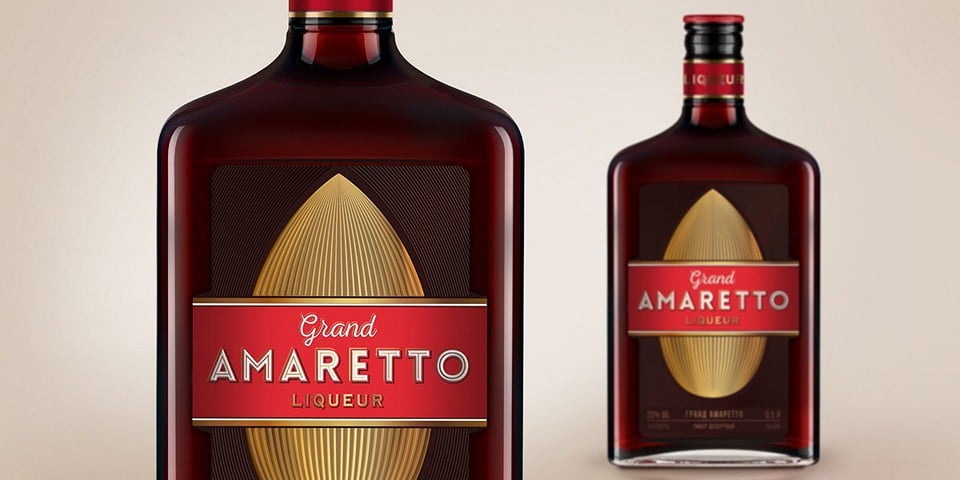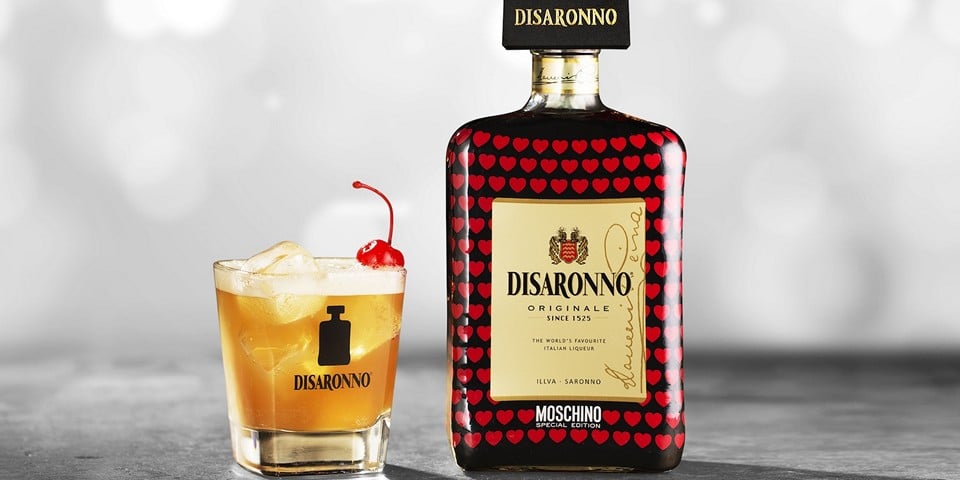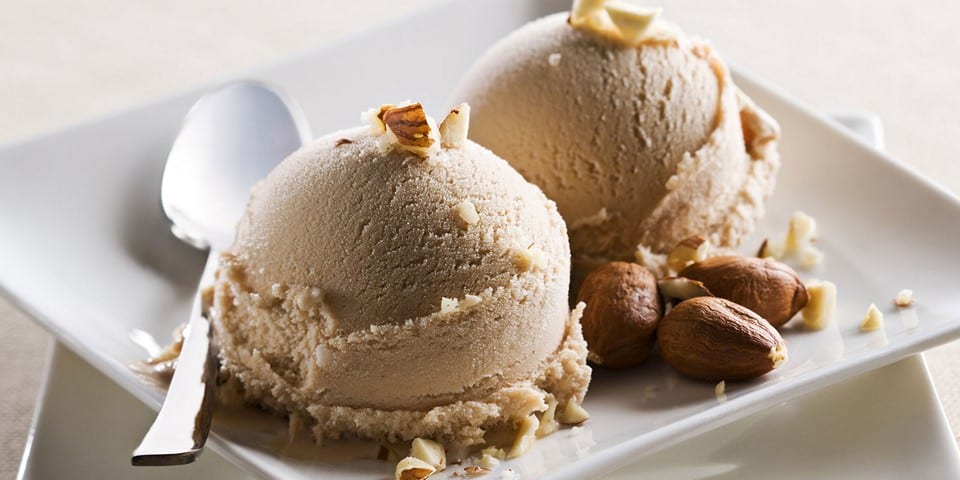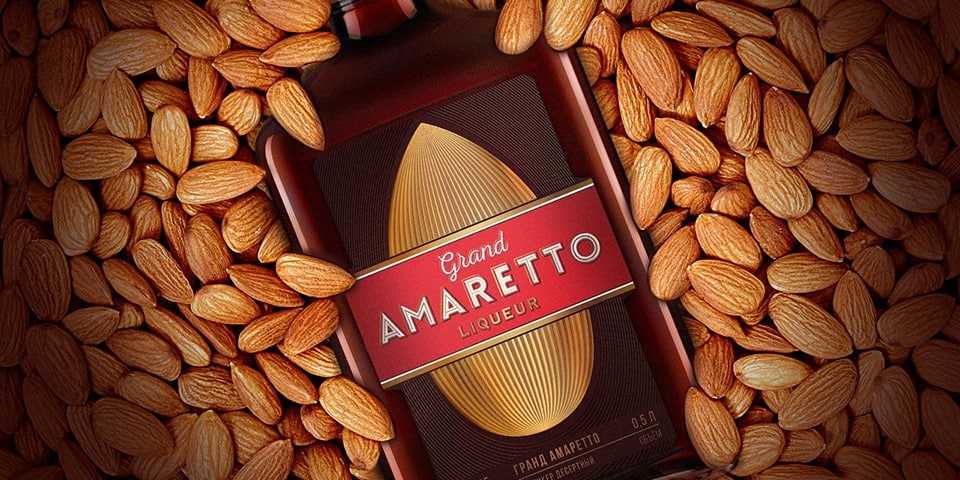How to celebrate a holiday in style and remember everything that happened in the morning? Italians have the answer. Their exquisite alcoholic beverages are highly regarded worldwide. One prominent representative of the Italian liquor world is Amaretto. It is a liqueur with an almond flavor. Surprisingly, some varieties of Amaretto don’t contain almonds at all. We will now tell you about the best brands that produce this wonderful drink, how it originated, and much more.

Page Contents
Varieties
If 50 years ago the alcohol market didn’t offer a wide variety of Amaretto, there was no question of choice. Nowadays, things are more complicated. Small companies may produce a liqueur filled with artificial colorings and flavorings instead of herbal extracts. Therefore, it is crucial to know the most famous brands. The oldest and most reputable brands are Amaretto Disaronno and Amaretto Lazzaroni:
- Amaretto Disaronno (Amaretto di Saronno), now known as Disaronno Originale, has a distinctive bittersweet almond flavor (although it doesn’t contain almonds or any other nuts) and contains 28% alcohol. It is famous for its original appearance: a rectangular glass decanter with a square cap. The liqueur is produced in Saronno but is sold worldwide. The company describes the drink’s composition as “an infusion of apricot kernel oil with alcohol, burnt sugar, and extracts from 17 herbs and fruits.” It has a vibrant amber color. Although customers still refer to Disaronno as Amaretto, the word “Amaretto” has been removed from its name since 2001.
- Amaretto Lazzaroni (Lazzaroni Amaretto) is a liqueur produced by Paolo Lazzaroni & Figli and is marketed as “one of a kind.” It is based on an infusion of amaretti cookies from Disaronno, which gives the drink its delicate almond-apricot aroma. It contains 24% alcohol. Its history dates back to 1718, and mass production began in 1851. The Lazzaroni family keeps the Amaretto recipe a closely guarded secret.
There are several other brands that produce worthy liqueurs, such as the Italian Luxardo, the Dutch Bols and De Kuyper, and the American Hiram Walker and Mr. Boston. Although Disaronno is no longer referred to as Amaretto, it is this variety of liqueurs that the world loves and knows. We will now acquaint ourselves with it in more detail.
History
The history of Disaronno can be considered the history of Amaretto. It spans almost half a millennium. Like many Italian products, the birth of this liqueur is associated with a beautiful legend.
The roots of liqueur trace back to one of the most magnificent, creative, and romantic periods – the Renaissance. In 1525, the artist Bernardino Luini was commissioned to create a fresco of the Madonna in Saronno. As a prototype, he chose a beautiful innkeeper from Saronno. In gratitude, she presented the master with a carafe of a fragrant, unique drink with an amber color. Thus, Amaretto came into existence as a gesture of goodwill, filled with secret ingredients.
The name “Amaretto” originated as a diminutive form of the word “amaro,” which means “bitter.” This refers to the taste of almond used in the recipe. The bitterness is not off-putting and is complemented by the addition of sugar. Therefore, the name of the liqueur can be translated as “a little bitter.” The similarity between the words “amaro” and “amore” (love) often leads to romantic associations.
In the early 20th century, Dominico Reina opened a shop in the center of Saronno. It was there that Disaronno Originale was mass-produced and released onto the market.
The very first bottle was classic, and then the producers gradually developed the original carafe. In 1942, the first square bottle was introduced, adding to the uniqueness and distinctiveness of Amaretto.
The first major export and surge of global popularity came in the 1960s. Initially, the liqueur triumphed across Europe and then conquered the United States. Its popularity outside of Italy turned out to be much higher than expected by the producers. In 1971, thanks to a master glassblower from Venice, the Disaronno bottle acquired its final design.
In 2001, the manufacturers made a clever marketing move. To distinguish their product from the line of Amaretto liqueurs, they decided to change its name to “Disaronno Originale.” Its recipe and production method remain the secret of the I.L.L.V.A. Saronno company.
Homemade Amaretto Recipe
Certainly, the recipe for homemade Amaretto is not very close to the original, but its taste will definitely delight you. With a small number of ingredients and minimal steps under your guidance, you will create a wonderful liqueur.
So, you will need:
- 0.5 liters of alcohol (90 proof);
- 0.5 liters of water;
- 350 grams of sugar;
- 250 grams of bitter almonds;
- 1 gram of cinnamon;
- 3 grams of coriander.
Grind the almonds and mix them with cinnamon and coriander. Place the spices in a glass container and pour the alcohol over them. Close the jar tightly and let it “rest” for 4 weeks in a dark, cool place.
Once the infusion is ready, remove the sediment by straining the solution. Boil the sugar with water for a few minutes (until it reaches a syrup consistency). Let it cool, then add the aromatic alcohol to it and transfer the solution to a bottle. Store it in a cool, dry place protected from light. After 3 months, you will have homemade Amaretto.
Recommendations
By following these brief recommendations, you can adjust the taste of homemade liqueur to your preferences:
- If you don’t appreciate the slight bitterness of Disaronno, you can replace bitter almonds with sweet ones.
- To achieve a more intense color, use brown sugar instead of white.
- The water should be bottled or purified, as impurities can affect the final taste of the drink.
- As additional spices, you can add crushed apricot kernels, dried cherries, or vanilla extract.
- If you’re in a hurry, you can skip the steeping period for the spices and replace them with ready-made extracts.
What to drink with and how to use in cooking
Amaretto can be enjoyed on its own or with the addition of ice. It pairs well with any aperitif, making it a great choice to accompany preferred appetizers. A popular combination is coffee with a splash of liqueur.
There are numerous alcoholic cocktails based on Amaretto. Among the most well-known and beloved are:
- French Connection: 1.5 fl oz (45 ml) Amaretto, 1.5 fl oz (45 ml) cognac, 2 ice cubes.
- Godfather: 1.5 fl oz (45 ml) whiskey, 1.5 fl oz (45 ml) Amaretto, 5 ice cubes.
- Godmother: 1.5 fl oz (45 ml) vodka, 1.5 fl oz (45 ml) Amaretto, ice cubes as desired.
- Goddaughter: 1.7 fl oz (50 ml) Amaretto, 1.7 fl oz (50 ml) cream, ice cubes.
- Hurricane Jenny: 1.7 fl oz (50 ml) Amaretto, 1.7 fl oz (50 ml) 7-Up or Sprite, ice cubes.
- Toasted Almond: 1.4 fl oz (40 ml) Amaretto, 1.4 fl oz (40 ml) Kahlua coffee liqueur, 0.8 fl oz (25 ml) cream, ice cubes.
- Lazy Lizard: 1.5 fl oz (45 ml) dark rum, 0.5 fl oz (15 ml) Amaretto, 6 fl oz (180 ml) cola, ice cubes.
- Almond Tree: Equal parts Amaretto, orange juice, soda water, and ice cubes.
- Amaretto Colada: 1.7 fl oz (50 ml) white rum, 1 fl oz (30 ml) Amaretto, 1 fl oz (30 ml) coconut liqueur, 4.4 fl oz (130 ml) pineapple juice.
- Amaretto Sour: 0.7 fl oz (20 ml) Amaretto, 1.4 fl oz (40 ml) bourbon, 0.5 fl oz (15 ml) lemon juice, 0.3 fl oz (10 ml) simple syrup, 0.3 fl oz (10 ml) egg white.
Amaretto is a key ingredient in many culinary recipes. It is added to desserts, including ice cream, to enhance the flavor. It intensifies the taste of almond-based pastries and complements the chocolate aroma. Tiramisu, a well-known Italian dessert, is often soaked in the original liqueur or its non-alcoholic version.
Amaretto is not limited to sweet recipes. It is used as a glaze for various types of meat, particularly chicken. Adding a few grams of Amaretto to pancake batter enriches its flavor.
Amaretto is an indispensable component in Almondine sauce, which is used to season fish and vegetables. If you enjoy making creamy cakes, a few drops of the liqueur will make the taste of your treat truly unforgettable.
Disaronno serves as an excellent substitute for Orgeat syrup in places where the latter is difficult to find or to reduce the sweetness of a dessert.
Price in Italy
In Italy, you can purchase Disaronno Originale for a price not exceeding 20 euros for 700 ml. A beverage from the Lazzaroni family will cost around 11 euros for 750 ml.
Now you know everything you need to choose a quality Amaretto. Live soberly, love intoxicatingly, and travel wisely. Fedor Uglov once said, “Speak the truth about alcohol to people, and they will stop drinking.” In paraphrasing the Soviet surgeon, we counter: “Speak the truth about Italian alcohol to people, and they will start drinking Amaretto!” But remember, alcoholic beverages are not a means to become an animal; they are an opportunity to enhance the taste of dishes and enjoy good times.
Interesting Facts
- Amaretto liqueur, a beloved Italian classic, originated in the early 16th century. Its recipe, which includes a blend of almonds, spices, and apricot pits, has been carefully guarded and passed down through generations, ensuring its authentic taste and quality.
- The name “Amaretto” is derived from the Italian word “amaro,” meaning bitter. However, don’t let the name deceive you. While it does have a hint of bitterness, it is primarily known for its delightful sweet and nutty flavor profile.
- The iconic brand Disaronno, one of the most popular producers of Amaretto, has a fascinating history. It can trace its roots back to 1525 when a young artist in Saronno gifted the secret recipe to a widow as a token of gratitude for her hospitality. This recipe eventually became the foundation of Disaronno, which is still enjoyed worldwide today.
- Amaretto is incredibly versatile and can be enjoyed in various ways. It is commonly sipped neat or on the rocks, allowing the rich flavors to shine. Additionally, it serves as a key ingredient in numerous classic cocktails, such as the Amaretto Sour and the Godfather.
- The almond flavor in Amaretto is not derived from almonds alone. Instead, it is achieved by using a combination of apricot kernels and a unique blend of herbs and spices. This carefully crafted combination gives the liqueur its distinct taste, making it a true Italian gem.
- Amaretto has found its way into the culinary world, enhancing both sweet and savory dishes. It is often used in desserts like tiramisu, ice creams, and pastries, imparting a delightful almond twist. Furthermore, it can be incorporated into sauces for meat and poultry, adding depth and complexity to savory recipes.
- Each bottle of Amaretto holds more than just a delicious liqueur; it represents a rich cultural heritage. The craftsmanship and attention to detail in producing Amaretto reflect Italy’s passion for quality and tradition. Whether enjoyed as an after-dinner indulgence or incorporated into culinary creations, Amaretto offers a taste of Italian elegance and sophistication.
 Italy for me From Italy with love
Italy for me From Italy with love









